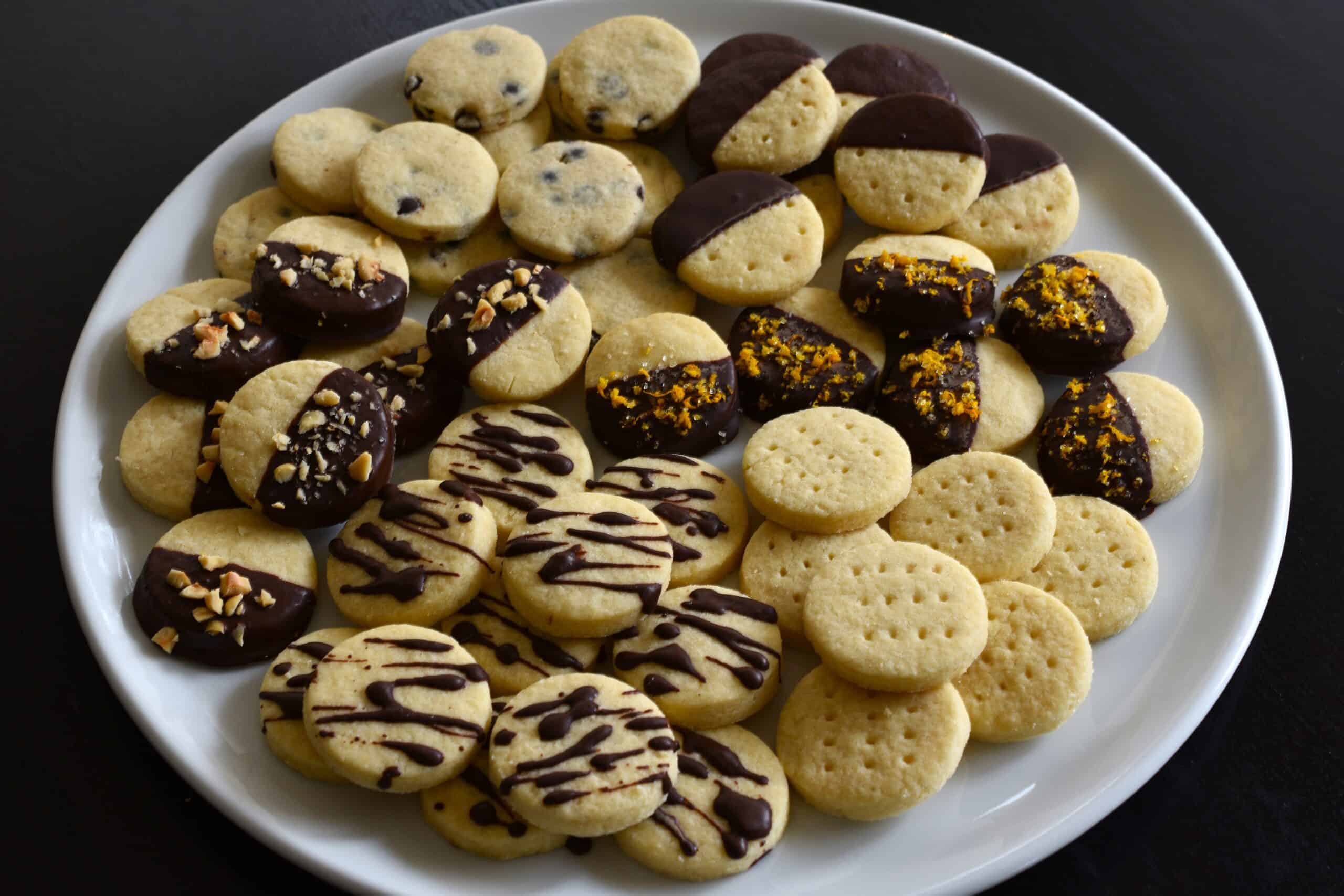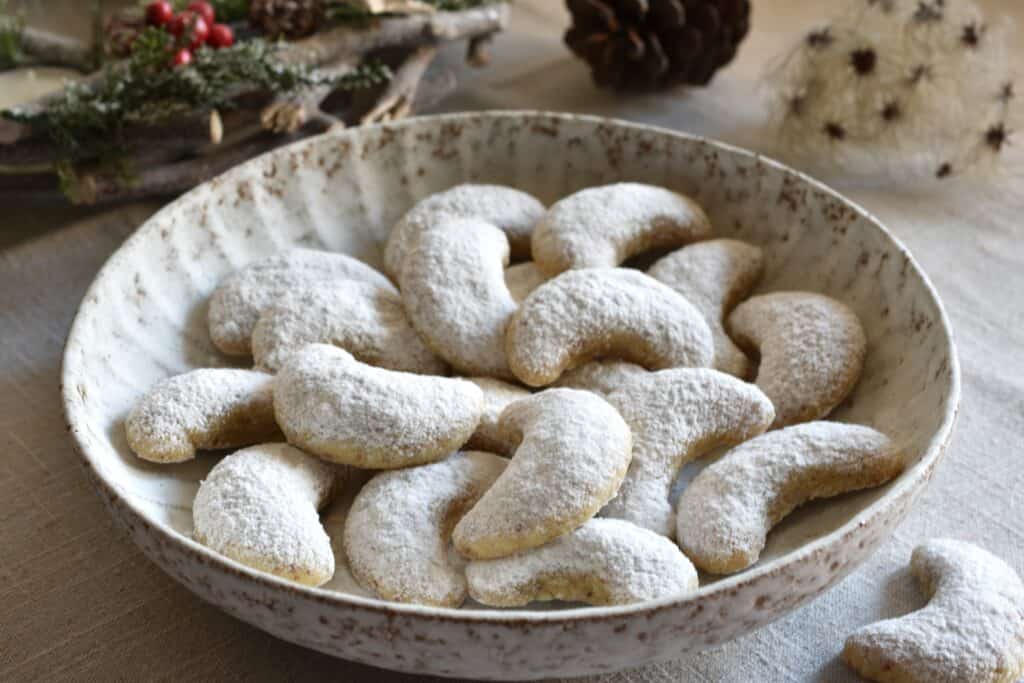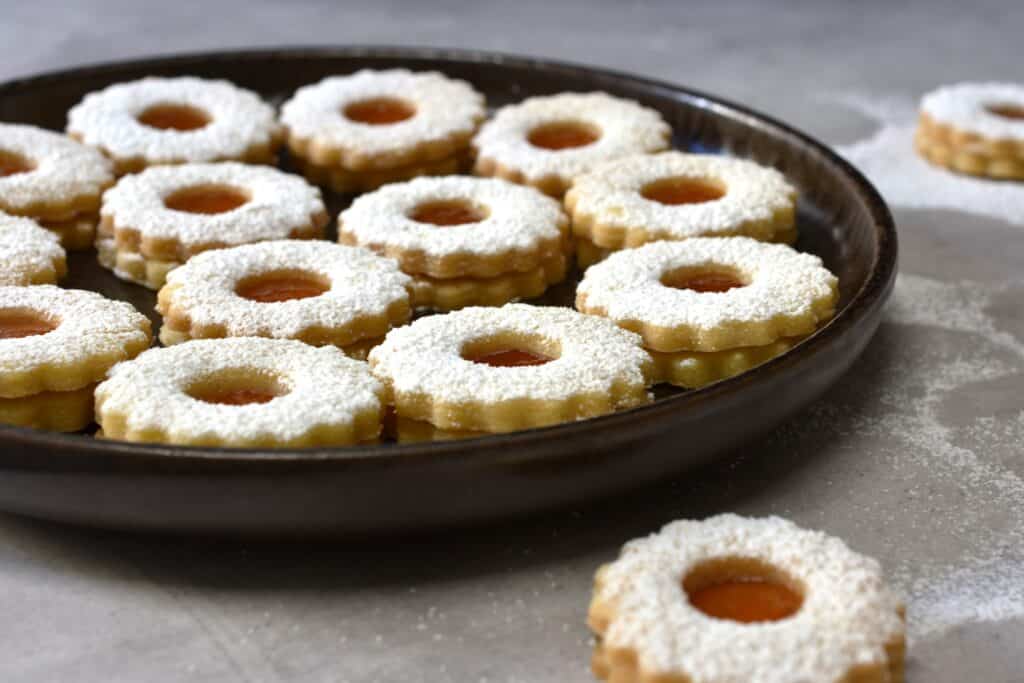These vegan double chocolate crinkle cookies are out-of-this-world indulgent with their soft, melt-in-your-mouth brownie-like texture and raspberry-flavoured centre! Actually, these should come with a warning because once you’ve taken a bite, you’ll be hooked! These little beauties are unforgettable – I can guarantee that because nobody ever forgets to ask me where they are at Christmastime!
Baking guetzli (the Swiss word for cookies) is an important tradition during the run-up to Christmas here in Switzerland, and it’s unbelievable how many different varieties there are! Apart from these raspberry double chocolate crinkle cookies, we also make jam-filled Spitzbuben, Austrian Vanillekipferl (vanilla crescent cookies), pizzicotti (Sicilian almond cookies), chocolate-dipped Scottish shortbread biscuits, cinnamon stars, Swiss mailänderli, and baci di dama from the Piedmont region in northern Italy. Everyone has their own personal favourites, but these double chocolate crinkle cookies are always one of the most popular!

How are these double chocolate crinkle cookies made?
These aren’t your average chocolate crinkle cookies – they’re double chocolate – made with indulgent dark chocolate and raw organic cacao powder. What makes them so unique and unforgettable is the raspberry jam centre! You can make them with or without the sugar coating. Below, you’ll find instructions for both versions, along with all the reasons why you might choose one over the other.
These cookies are simple to make, although filling them with raspberry jam might be a bit fiddly for some. For an easy, fuss-free variation, you can leave out the jam filling – it won’t affect the appearance or texture of the cookies at all. But if you do have the time and patience, I really recommend going the extra mile with the raspberry filling, especially if you’re making them for a special occasion like Christmas or Thanksgiving.

How to make vegan double chocolate crinkle cookies
For the best results, I recommend you read the ingredient list and instructions below before jumping to the recipe card.
Ingredients
You’ll find the exact quantities of each ingredient in the recipe card at the bottom of the page.
Flour
You’ll need plain, all-purpose flour for this recipe. I haven’t tried making these gluten-free. If you do some experimenting of your own, let me know how it goes in the comments below!
Cacao powder
Choose organic, raw cacao powder wherever possible – it makes the best double chocolate crinkle cookies! Also, according to this article by Be Good Organics, raw cacao powder is a rich source of antioxidants, flavonoids, and minerals such as iron, magnesium, potassium, and calcium.
Remember that cocoa powder and cacao powder are not the same thing. Cacao (pronounced ka kaw) is not to be confused with cocoa (pronounced coco). The term cacao is used when referring to unprocessed versions of the cacao bean.
Cocoa, on the other hand, refers to cacao which has undergone industrial refining, chemical processing and roasting. Unfortunately, these processes tend to destroy a lot of the original nutrients.
Read more about cacao versus cocoa powder.
Cacao powder has a deeper, more intense chocolate flavour with fruity and slightly bitter notes, which make the cookies taste more luxurious and indulgent.
Baking powder
Baking powder serves as a leavening agent, creating a lighter, softer texture. It also helps the cookies to expand and crack on the surface, forming the signature crinkle pattern.
Salt
The small amount of salt in this recipe enhances the flavour of the chocolate and balances out the sweetness.
Dark chocolate
Use dark chocolate for crinkle cookies; 70% or 80% cacao is ideal. I use Lindt Excellence 70% or 85% cacao.
Vegan butter
Any kind of vegan block butter will work for these double chocolate crinkle cookies. My favourites are Vegan Block by Naturlì, Vioblock by Violife and Flora (the block in the red packet)
Aquafaba
Aquafaba replaces the eggs in traditional recipes for double chocolate crinkle cookies. Egg white, or in this case aquafaba, serves as a binder to hold the dough together, making it easier to handle and shape into balls. Don’t worry, you won’t be able to detect the taste of the chickpeas at all!
If you’re a new vegan, maybe you’re not sure what aquafaba is or how to use it. It’s what we vegans use to substitute eggs in a lot of recipes, in particular those that call for egg whites. Aquafaba is basically the water that chickpeas have been cooked in. Its composition of carbohydrates, proteins, and other soluble plant solids, which have migrated from the legumes to the water during cooking, gives it a broad spectrum of emulsifying, foaming, binding, gelatinising and thickening properties very similar to those of eggs. You can even make meringues and pavlova with aquafaba!
If you’re interested, I’ve written a complete guide on aquafaba: how to make it from dried or tinned chickpeas; how to whip it and how to use it in savoury recipes or desserts; how to troubleshoot if your aquafaba won’t whip.
If you don’t want to use aquafaba for some reason, you could try using the same amount of plant-based milk instead.
Sugar
You’ll need castor (caster) sugar for both the biscuit dough and the sugar coating (if you decide to sugarcoat them).
Castor sugar is ideal because it’s more finely ground than ordinary granulated sugar, ensuring it dissolves properly in the dough. I use brown castor sugar for the biscuit dough because it’s less refined than white and arguably not as bad for you as refined white sugar. No one will notice the colour of the sugar because there’s a lot of chocolate in this recipe. Brown sugar has a richer, more complex flavour, often described as caramel-like or slightly toasty, which is great for making chocolate biscuits.
For the sugar coating, you’ll need white castor sugar, not brown, because you’ll want the sugar coasting to be as white as possible! Remember that not all white sugar is vegan. I used a vegan brand of white castor sugar. If you’re a new vegan, be warned that bone char is often used in the refining process of white sugar and sometimes brown sugar, too. Check the labels to be sure. You’ll also need icing sugar for the coating (see below).
Vanilla
The recipe calls for vanilla sugar, which is widely available in Europe. If you don’t have vanilla sugar where you live, replace it with castor sugar and a couple of drops of vanilla extract or essence.
Raspberry jam (optional)
I make my own raspberry jam with the raspberries that grow in my garden for 6 months a year! Shop-bought raspberry jam is perfectly fine. You might want to filter out the seeds by putting the jam through a sieve. You could substitute raspberry with a different flavoured jam if you prefer. I think cherry would also be a really nice alternative.
Icing sugar
Icing sugar (aka powdered sugar or confectioners’ sugar) forms the second layer of the sugar coating before the cookies go into the oven. First, they are lightly rolled in castor sugar, which prevents the cookies from developing a yellowish tinge caused by fat seeping into the icing sugar during baking. This thin layer of caster sugar acts as a barrier, allowing the icing sugar to stay pristine and white. Together, they create the signature crunchy, sugar-coated exterior of chocolate chip crinkle cookies.

How to make double chocolate crinkle cookies
with or without sugar coating?
Rolled in sugar, these double chocolate temptations are more like a traditional chocolate crinkle cookie with a typical crunchy exterior. If you follow the instructions carefully, you’ll be able to keep the sugar coating looking perfect for a week or even longer. Mine still looked good after two weeks.
Without the sugar coating, they remain softer on the surface and more brownie-like. I can’t say I have a preference for one over the other, but for festive occasions, I always sugarcoat them. Both variations are delicious in their own right.


Instructions
You’ll find step-by-step instructions with photos in the recipe card at the bottom of this page.
Make the dough
- Mix the flour, cocoa powder, baking powder and salt in a bowl (omit the salt if using salted butter).
- Melt the chocolate and vegan butter in a saucepan. When melted, remove from the heat.
- Put the aquafaba, sugar and vanilla sugar in a bowl and mix together. It isn’t necessary to whip the aquafaba.
- Add the melted chocolate and butter to the aquafaba and sugar. Mix well with a spatula.
- Add the dry ingredients a little at a time and combine everything to form a dough. Cover with the cling film and refrigerate for about an hour or until it’s firm enough to handle.
raspberry filling (optional)
- Remove the biscuit dough from the fridge. Break off pieces weighing approximately 15 g and an equal number weighing 4 – 5 g. Roll the 15 g pieces into balls and shape the small pieces into small domes, as shown in the photos in the recipe card below.
- Make a deep hole in the centre of each ball for the jam. I use my little finger for this. Pipe raspberry jam into the holes and then use the dome-shaped pieces as a lid to seal in the jam. Roll the balls again carefully between your hands so that the seams disappear.
- Line a large flat plate or baking tray with a sheet of baking paper. Place the balls on the baking paper (this will stop them from sticking to the plate or tray). Refrigerate the balls for an hour so that they harden again.
The secret to sugarcoating double chocolate crinkle cookies successfully
- First, roll the chocolate balls in castor sugar until they are lightly coated all over. Then, go heavy with the icing sugar, making sure each ball is thickly coated for a snowy white finish.
How long to bake double chocolate crinkle cookies
- Preheat the oven to 180 ºC.
- Place a sheet of parchment paper on a cold oven tray. Arrange the balls in rows, spacing them about 3 – 4 cm apart because they spread in the oven.
- Put the oven tray in the centre of the oven and bake the biscuits at 180 °C for 13 -15 minutes. Check on them after 12 minutes. If necessary, gently bang the baking tray on the counter a couple of times to encourage crinkling and spreading.
- Remove the tray from the oven and allow the biscuits to cool before touching them.

How to store double chocolate crinkle cookies
To keep your double chocolate crinkle cookies looking their best for as long as possible, follow these simple storage tips and tricks. The biggest challenge is maintaining the pure white icing sugar coating. Because these cookies are so moist and fudgy, the icing sugar tends to absorb some of that moisture over time, causing it to appear slightly damp or yellowish. The layer of castor sugar all but eliminates this problem. However, incorrect storage or freezing can exacerbate this issue. If you plan to freeze them, I recommend doing so before coating them in icing sugar (see the instructions for freezing below).
Store your double chocolate crinkle cookies in an airtight container or biscuit tin to prevent them from drying out or becoming too soft. Place a sheet of parchment paper between layers to keep the cookies from sticking together and messing up the icing sugar coating. Keep them in a cool, dry place, ideally at around 15-20°C (59-68°F), away from direct sunlight or humidity, as moisture can cause the icing sugar to dissolve or discolour. Your cookies will stay fresh for 1-2 weeks stored in this way.

Can you freeze double chocolate crinkle cookies?
If you want to freeze double chocolate crinkle cookies, it’s best to do so before coating them in sugar:
Freeze the jam-filled balls on a baking tray lined with parchment paper. Then, transfer the frozen dough balls to a freezer bag or airtight container and store them in the freezer for up to 3 months. When ready to bake, let the balls thaw slightly at room temperature. You can then coat them in castor sugar and icing sugar before baking.
While you can freeze fully baked cookies, keep in mind that coating them in icing sugar might result in them absorbing moisture during freezing. For the best results, freeze uncoated dough balls instead.
I’m sure you’ll love this recipe for vegan double chocolate crinkle cookies! If you try it and like it, I’d love to hear about it! Let me know in the comments below, or take a quick pic and share it on social media. Don’t forget to tag me on Instagram or Facebook vegan_hot_stuff. I love seeing your re-creations!
Frequently asked questions
Can this recipe be made ahead?
Yes, you can make these double chocolate crinkle cookies ahead. Store them in an airtight container with a layer of parchment paper between each layer to prevent the icing sugar from smudging. Alternatively, you could make biscuit dough ahead and store it in cling film in the fridge for 3 – 4 days.
Why do double chocolate crinkle cookies need to be rolled in two types of sugar?
Rolling the crinkle cookies in castor sugar first creates a dry barrier that prevents the powdered sugar from dissolving into the dough. That way, the icing (powdered) sugar remains pure white.
How do I keep the sugar coating white and prevent it from dissolving?
To prevent the sugar from dissolving, make sure the cookie dough is cold before rolling. Rolling first in castor sugar also helps. Additionally, use a generous amount of Icing (powdered) sugar for an even coating.
What happens if I skip the castor sugar layer?
Without the castor sugar layer, the icing (powdered) sugar may dissolve into the moist dough during baking, leading to a yellowy or patchy appearance rather than a snowy white finish.
Can I use powdered sugar alone for coating?
Yes, but the powdered sugar could partially dissolve without the castor sugar barrier, negatively affecting the final appearance.
Why didn’t my double chocolate crinkle cookies spread properly?
If your cookies didn’t spread, the dough might have been too cold, or you may have used too much flour, making it too stiff. Also, ensure your baking powder is fresh, as it helps the cookies spread and crack.
What causes the cracks in crinkle cookies?
The cracks are created by the dough expanding and spreading during baking. As the exterior of the dough sets quickly in the oven, the interior continues to expand, forcing cracks to form on the surface.
How can I ensure my cookies have deep, defined cracks?
Use a well-chilled dough to allow the exterior to set before the interior fully expands. Bake at a relatively high temperature (180°C/350°F) for the best contrast between the cracks and the interior.
Why are my double chocolate crinkle cookies dry and crumbly?
Overbaking is the most common culprit. Bake the cookies until they are just set at the edges but still soft in the middle. Measure your ingredients accurately, especially flour, to avoid a dry dough.
Can I chill the dough before rolling and baking?
Yes, chilling the dough is essential for easier handling and helps achieve a better texture and more defined cracks.
My double chocolate crinkle cookies turned out too flat—what went wrong?
Flat cookies can result from not chilling the dough enough or using too little flour. Also, ensure your baking soda is active and avoid overmixing the dough.
How can I make these double chocolate crinkle cookies gluten-free?
Replace the all-purpose flour with a 1:1 gluten-free flour blend. Check that other ingredients, like chocolate, are gluten-free as well.
Are there any alternatives to raspberry jam for the filling?
Yes, you can use other jams like cherry, strawberry, or apricot. Nut butter, caramel, or even vegan chocolate spread would work, too.
I hope you enjoy this recipe for vegan double chocolate crinkle cookies! If you do, it would be great if you could give it a star rating and leave a comment below! It helps other readers find my content and posts and ultimately makes my blog more successful! Thanks so much for your support! Deborah xx
Before you go, maybe you’d like to take a look at some other great vegan Christmas cookie recipes…




Would you like to receive my recipes as soon as I publish them? Subscribe below!





















Buoniiiiii😋
Thank you for the review! I really appreciate it!